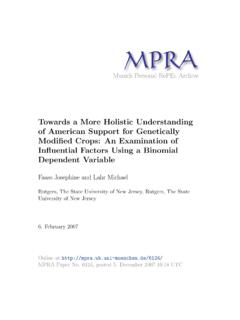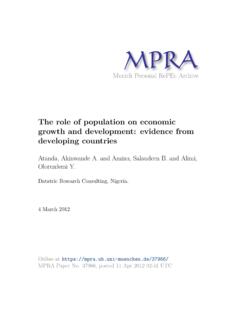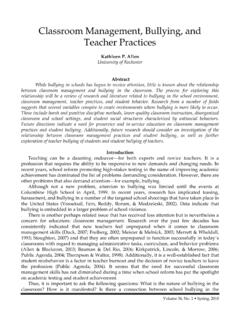Transcription of Qualitative Research Methodology in Social Sciences and ...
1 Munich Personal RePEc ArchiveQualitative Research Methodology inSocial Sciences and Related SubjectsMohajan, HaradhanAssistant Professor, Premier University, Chittagong, December 2018 Online Paper No. 85654, posted 04 Apr 2018 12:47 UTCJ ournal of Economic Development, Environment and People, Vol-7, Issue 01, 2018, pp. 23-48 1 Qualitative Research Methodology in Social Sciences and Related Subjects Haradhan Kumar Mohajan Premier University, Chittagong, Bangladesh Tel: +8801716397232 Email: Abstract This literature review paper discusses the proper use of Qualitative Research Methodology to discuss several aspects of the Research for the improvement of the skill of the readers. During the last few decades, the use of Qualitative Research has been increased in many institutions.
2 It can be used to explore several areas of human behavior for the development of organizations. The purpose of this study is to provide inspirations to the new researchers for the development of their Qualitative articles. The paper analyzes the design of Qualitative Research giving some methodological suggestions to make it explicable to the reader. In this paper an attempt has been taken to study the background of the Qualitative Research Methodology in Social Sciences and some other related subjects, along with the importance, and main features of the study. Keywords: Research Methodology , Qualitative Research , phenomenology, ethnography, narrative approach, grounded theory, content analysis, action Research , historical Research , case study.
3 Introduction Every Research must involve an explicit, disciplined, systematic (planned, ordered, and public) approach to find out most appropriate results. Qualitative Research is inductive in nature, and the researcher generally explores meanings and insights in a given situation [Strauss & Corbin, 2008; Levitt et al., 2017]. It refers to a range of data collection and analysis techniques that use purposive sampling and semi-structured, open-ended interviews [Dudwick et al., 2006; Gopaldas, 2016]. It is described as an effective model that occurs in a natural setting and enables the researcher to develop a level of detail from high involvement in the actual experiences [Creswell, 2009]. It Journal of Economic Development, Environment and People, Vol-7, Issue 01, 2018, pp.
4 23-48 2 consists of a set of interpretive material practices that makes the world visible. It is multi-method in focus, involving an interpretive, naturalistic approach to its subject matter [Denzin & Lincoln, 2005]. It is a type of Social science Research that collects and works with non-numerical data that seeks to interpret meaning from these data that help us to understand Social life through the study of targeted populations or places [Punch, 2013]. It is the observations and interpretations of people s perception of different events, and it takes the snapshot of the people s perception in a natural setting [Gentles et al., 2015]. It investigates local knowledge and understanding of a given program, people s experiences, meanings and relationships, and Social processes and contextual factors that marginalize a group of people.
5 It is less structured in description, because it formulates and builds new theories [Leedy & Ormrod, 2001]. It focuses on words rather than numbers, this type of Research observes the world in its natural setting, interpreting situations to understand the meanings that people make from day to day life [Walia, 2015]. Qualitative Research comprises of the following methods: logic, ethnography, discourse analysis, case study, open-ended interview, participant observation, counseling, therapy, grounded theory, biography, comparative method, introspection, casuistry, focus group, literary criticism, meditation practice, historical Research , etc. [Cibangu, 2012]. Qualitative Research is a form of Social action that stresses on the way of people interpret, and make sense of their experiences to understand the Social reality of individuals.
6 It makes the use of interviews, diaries, journals, classroom observations and immersions; and open-ended questionnaires to obtain, analyze, and interpret the data content analysis of visual and textual materials, and oral history [Zohrabi, 2013]. It is exploratory, and seeks to explain how and why a particular Social phenomenon, or program, operates as it does in a particular context. It tries to help us to understand the Social world in which we live, and why things are the way they are [Polkinghorne, 2005]. It has gained more and more area in the Social domain. It aims to provide a detail understanding into human behavior, emotion, attitudes, and experiences [Tong et al., 2012]. The main paradigms within the Qualitative Research are positivist, interpretivist, and critical paradigms [Punch, 2013].
7 It is used to explore the behavior, perspectives, feelings, and experiences of people, and what lies at the core of their lives. The basis of it lies in the interpretive approach to Social reality, and in the description of the lived experience of human beings [Atkinson et al., 2001]. It has a profound impact on the Research area of education, health care, nursing, sociology, anthropology, psychology, management, information systems, etc. [Denzin & Lincoln, 2005]. Qualitative researchers are interested in people s belief, experience, and meaning systems from the perspective of the people. Qualitative Research does not include statistical analysis and empirical calculation [Brink, 1993]. The roots of Qualitative Research lie in Social and cultural anthropology, philosophy, psychology, history, and sociology.
8 The goal of the Qualitative tradition is a deep understanding of the particular [Domholdt, 1993]. The purpose of Qualitative Research is to describe and interpret issues or phenomena systematically from the point of view of the individual or population being studied, and to generate new concepts and theories. The choice of Methodology is directed by the questions being raised [Viswambharan & Priya, 2016]. Journal of Economic Development, Environment and People, Vol-7, Issue 01, 2018, pp. 23-48 3 Recently interest in Social Sciences of Qualitative Research is growing remarkably. The rapid rise of Qualitative Research to prominence in scientific communities; considerable debate has ensued regarding epistemological, philosophical, and methodological issues [Spencer et al.]
9 , 2003]. Literature Review Burns and Grove [2009] have provided their opinions that Qualitative Research is a systematic and subjective approach to highlight and explain daily life experiences, and to further give them proper meaning. Alberto Crescentini and Giuditta Mainardi have presented some guidelines, and suggestions for the preparation of a good Qualitative Research paper [Crescentini & Mainardi, 2009]. Svend Brinkmann, Michael Hviid Jacobsen, and S ren Kristiansen have discussed six histories of Qualitative Research as: i) the conceptual, ii) the internal, iii) the marginalizing, iv) the repressed, v) the Social , and vi) the technological histories of Qualitative Research [Brinkmann et al., 2014]. Md Shidur Rahman has discussed the advantages and disadvantages of using Qualitative and quantitative approaches and methods in language [Rahman, 2017].
10 Looi Theam Choy has compared strengths and weaknesses of both Qualitative and quantitative Research methodologies in Social Sciences [Choy, 2014]. In the grounded theory Qualitative method has used by Williams and Irurita [2005] to study the personal control and emotional comfort of hospitalized patients. Interviews are conducted with 40 patients, and 75 hours of field observations. Personal control referred to the ability of patients to influence their environment; emotional comfort was defined as a state of relaxation that affected the physical status of the patient. In a case study of launching a product on a new market, Luminita Pistol and Rocsana Bucea-Manea-Tonis have applied conjoint analysis approach to imitate and determine the optimal marketing mix for a Romanian company that struggles to face the market higher competition.













